Facile Synthesis of Nitrogen-Rich Porous Carbon/NiMn Hybrids Using Efficient Water-Splitting Reaction
Abstract
:1. Introduction
2. Materials and Methods
2.1. Synthesis of Hydroquinone-Phenylethylamine-Based Benzoxazine Monomer (HPh-Bzo)
2.2. Synthesis of Nitrogen-Rich Porous Carbon (NRPC)
2.3. Synthesis of NRPC/Mn, NRPC/Ni and NRPC/NiMn
2.4. Electrochemical Measurements
3. Instrumentation
4. Results and Discussion
4.1. Analysis of the Structure of the Prepared Materials
4.2. Fabrication of Working Electrode
4.3. Electrochemical Studies
5. Conclusions
Author Contributions
Funding
Institutional Review Board Statement
Data Availability Statement
Acknowledgments
Conflicts of Interest
References
- Qin, Q.; Chen, L.; Wei, T.; Wang, Y.; Liu, X. Ni/NiM2O4 (M = Mn or Fe) supported on N-doped carbon nanotubes as trifunctional electrocatalysts for ORR, OER and HER. Catal. Sci. Technol. 2019, 9, 1595–1601. [Google Scholar] [CrossRef]
- Zhai, Y.; Ren, X.; Sun, Y.; Li, D.; Wang, B.; Liu, S. Synergistic effect of multiple vacancies to induce lattice oxygen redox in NiFe-layered double hydroxide OER catalysts. Appl. Catal. B Environ. 2023, 323, 122091. [Google Scholar] [CrossRef]
- Thangavel, P.; Lee, H.; Kong, T.H.; Kwon, S.; Tayyebi, A.; Lee, J.H.; Choi, S.M.; Kwon, Y. Immobilizing Low-Cost Metal Nitrides in Electrochemically Reconstructed Platinum Group Metal (PGM)-Free Oxy-(Hydroxides) Surface for Exceptional OER Kinetics in Anion Exchange Membrane Water Electrolysis. Adv. Energy Mater. 2023, 13, 2203401. [Google Scholar] [CrossRef]
- Zhang, Q.; Li, X.L.; Tao, B.X.; Wang, X.H.; Deng, Y.H.; Gu, X.Y.; Li, L.J.; Xiao, W.; Li, N.B.; Luo, H.Q. CoNi based alloy/oxides@N-doped carbon core-shell dendrites as complementary water splitting electrocatalysts with significantly enhanced catalytic efficiency. Appl. Catal. B Environ. 2019, 254, 634–646. [Google Scholar] [CrossRef]
- Thangavel, P.; Ha, M.; Kumaraguru, S.; Meena, A.; Singh, A.N.; Harzandi, A.M.; Kim, K.S. Graphene-nanoplatelets-supported NiFe-MOF: High-efficiency and ultra-stable oxygen electrodes for sustained alkaline anion exchange membrane water electrolysis. Energy Environ. Sci. 2020, 13, 3447–3458. [Google Scholar] [CrossRef]
- Sultan, S.; Tiwari, J.N.; Singh, A.N.; Zhumagali, S.; Ha, M.; Myung, C.W.; Thangavel, P.; Kim, K.S. Single Atoms and Clusters Based Nanomaterials for Hydrogen Evolution, Oxygen Evolution Reactions, and Full Water Splitting. Adv. Energy Mater. 2019, 9, 1900624. [Google Scholar] [CrossRef]
- Roger, I.; Shipman, M.A.; Symes, M.D. Earth-abundant catalysts for electrochemical and photoelectrochemical water splitting. Nat. Rev. Chem. 2017, 1, 0003. [Google Scholar] [CrossRef]
- Niu, Y.; Huang, X.; Zhao, L.; Hu, W.; Li, C.M. One-Pot Synthesis of Co/CoFe2O4 Nanoparticles Supported on N-Doped Graphene for Efficient Bifunctional Oxygen Electrocatalysis. ACS Sustain. Chem. Eng. 2018, 6, 3556–3564. [Google Scholar] [CrossRef]
- Jia, N.; Weng, Q.; Shi, Y.; Shi, X.; Chen, X.; Chen, P.; An, Z.; Chen, Y. N-doped carbon nanocages: Bifunctional electrocatalysts for the oxygen reduction and evolution reactions. Nano Res. 2018, 11, 1905–1916. [Google Scholar] [CrossRef]
- Zhang, J.; Qu, L.; Shi, G.; Liu, J.; Chen, J.; Dai, L. N,P-codoped carbon networks as efficient metal-free bifunctional catalysts for oxygen reduction and hydrogen evolution reactions. Angew. Chem. Int. Ed. 2016, 55, 2230–2234. [Google Scholar] [CrossRef]
- Ma, Y.; Dai, X.; Liu, M.; Yong, J.; Qiao, H.; Jin, A.; Li, Z.; Huang, X.; Wang, H.; Zhang, X. Strongly Coupled FeNi Alloys/NiFe2O4@Carbonitride Layers-Assembled Microboxes for Enhanced Oxygen Evolution Reaction. ACS Appl. Mater. Interfaces 2016, 8, 34396–34404. [Google Scholar] [CrossRef] [PubMed]
- Ge, X.; Chen, L.; Zhang, L.; Wen, Y.; Hirata, A.; Chen, M. Nanoporous metal enhanced catalytic activities of amorphous molybdenum sulfide for high-efficiency hydrogen production. Adv. Mater. 2014, 26, 3100–3104. [Google Scholar] [CrossRef] [PubMed]
- Gao, M.R.; Xu, Y.F.; Jiang, J.; Zheng, Y.R.; Yu, S.H. Water oxidation electrocatalyzed by an efficient Mn3O4/CoSe2 nanocomposite. J. Am. Chem. Soc. 2012, 134, 2930–2933. [Google Scholar] [CrossRef] [PubMed]
- Wei, X.; Zhang, B.; Liao, M.; Xiao, P.; Zhou, X.; Zhang, Y.; Liu, J. Controllable synthesis of layered K0.296Mn0.926O2 to assemble 2.4 V aqueous potassium-ion supercapacitors for double high devices. J. Mater. Chem. A 2020, 8, 17248–17256. [Google Scholar] [CrossRef]
- Cai, H.; Wang, B.; Xiong, L.; Yang, G.; Yuan, L.; Bi, J.; Yu, X.; Zhang, X.; Yang, S.; Yang, S. Bridging effect of Co heteroatom between g-C3N4 and Pt NPs for enhanced photocatalytic hydrogen evolution. Chem. Eng. J. 2020, 394, 124964. [Google Scholar] [CrossRef]
- Hu, Q.; Tang, M.; He, M.; Jiang, N.; Xu, C.; Lin, D.; Zheng, Q. Core-shell MnO2@CoS nanosheets with oxygen vacancies for high-performance supercapattery. J. Power Sources 2020, 446, 227335. [Google Scholar] [CrossRef]
- Jing, C.; Song, X.; Li, K.; Zhang, Y.; Liu, X.; Dong, B.; Dong, F.; Zhao, S.; Yao, H.; Zhang, Y. Optimizing the rate capability of nickel cobalt phosphide nanowires on graphene oxide by the outer/inter-component synergistic effects. J. Mater. Chem. A 2020, 8, 1697–1708. [Google Scholar] [CrossRef]
- Sun, W.; Du, Y.; Wu, G.; Gao, G.; Zhu, H.; Shen, J.; Zhang, K.; Cao, G. Constructing metallic zinc-cobalt sulfide hierarchical core-shell nanosheet arrays derived from 2D metal-organic-frameworks for flexible asymmetric supercapacitors with ultrahigh specific capacitance and performance. J. Mater. Chem. A 2019, 7, 7138–7150. [Google Scholar] [CrossRef]
- Xu, X.; Shao, Z.; Jiang, S.P. High-entropy materials for water electrolysis. Energy Technol. 2022, 10, 2200573. [Google Scholar] [CrossRef]
- Xu, X.; Pan, Y.; Ge, L.; Chen, Y.; Mao, X.; Guan, D.; Li, M.; Zhong, Y.; Hu, Z.; Peterson, V.K.; et al. High-performance perovskite composite electrocatalysts enabled by controllable interface engineering. Small 2021, 17, 2101573. [Google Scholar] [CrossRef]
- Tang, J.; Xu, X.; Tang, T.; Zhong, Y.; Shao, Z. Perovskite-based electrocatalysts for cost-effective ultrahigh-current-density water splitting in anion exchange membrane electrolyzer cell. Small Methods 2022, 6, 2201099. [Google Scholar] [CrossRef]
- Jiang, J.; Liu, J.; Zhou, W.; Zhu, J.; Huang, X.; Qi, X.; Zhang, H.; Yu, T. CNT/Ni hybrid nanostructured arrays: Synthesis and application as high-performance electrode materials for pseudocapacitors. Energy Environ. Sci. 2011, 4, 5000–5007. [Google Scholar] [CrossRef]
- Kagunya, W.; Baddour-Hadjean, R.; Kooli, F.; Jones, W. Vibrational modes in layered double hydroxides and their calcined derivatives. Chem. Phys. 1998, 236, 225–234. [Google Scholar] [CrossRef]
- Yuge, R.; Miyawaki, J.; Ichihashi, T.; Kuroshima, S.; Yoshitake, T.; Ohkawa, T.; Aoki, Y.; Iijima, S.; Yudasaka, M. Highly efficient field emission from carbon nanotube—Nanohorn hybrids prepared by chemical vapor deposition. ACS Nano 2010, 4, 7337–7343. [Google Scholar] [CrossRef] [PubMed]
- Fan, Z.J.; Yan, J.; Wei, T.; Ning, G.Q.; Zhi, L.J.; Liu, J.C.; Cao, D.X.; Wang, G.L.; Wei, F. Nanographene-constructed carbon nanofibers grown on graphene sheets by chemical vapor deposition: High-performance anode materials for lithium ion batteries. ACS Nano 2011, 5, 2787–2794. [Google Scholar] [CrossRef] [PubMed]
- Wu, J.; Zhang, D.; Wang, Y.; Hou, B. Electrocatalytic activity of nitrogen-doped graphene synthesized via a one-pot hydrothermal process towards oxygen reduction reaction. J. Power Sources 2013, 227, 185–190. [Google Scholar] [CrossRef]
- Kerisit, S.; Schwenzer, B.; Vijayakumar, M. Effects of oxygen-containing functional groups on supercapacitor performance. J. Phys. Chem. Lett. 2014, 5, 2330–2334. [Google Scholar] [CrossRef]
- Lee, J.W.; Ahn, T.; Kim, J.H.; Ko, J.M.; Kim, J.D. Nanosheets based mesoporous NiO microspherical structures via facile and template-free method for high performance supercapacitors. Electrochim. Acta 2011, 56, 4849–4857. [Google Scholar] [CrossRef]
- Xing, W.; Li, F.; Yan, Z.F.; Lu, G.Q. Synthesis and electrochemical properties of mesoporous nickel oxide. J. Power Sources 2004, 134, 324–330. [Google Scholar] [CrossRef]
- Wu, Y.Q.; Chen, X.Y.; Ji, P.T.; Zhou, Q.Q. Sol-gel approach for controllable synthesis and electrochemical properties of NiCo2O4 crystals as electrode materials for application in supercapacitors. Electrochim. Acta 2011, 56, 7517–7522. [Google Scholar] [CrossRef]
- Lu, X.; Huang, X.; Xie, S.; Zhai, T.; Wang, C.; Zhang, P.; Yu, M.; Li, W.; Liang, C.; Tong, Y. Controllable synthesis of porous nickel-cobalt oxide nanosheets for supercapacitors. J. Mater. Chem. 2012, 22, 13357–13364. [Google Scholar] [CrossRef]
- Aasen, D.; Clark, M.P.; Ivey, D.G. Investigation of Transition Metal-Based (Mn, Co, Ni, Fe) Trimetallic Oxide Nanoparticles on N-doped Carbon Nanotubes as Bifunctional Catalysts for Zn-Air Batteries. J. Electrochem. Soc. 2020, 167, 040503. [Google Scholar] [CrossRef]
- Andreas, H.A.; Conway, B.E. Examination of the double-layer capacitance of an high specific-area C-cloth electrode as titrated from acidic to alkaline pHs. Electrochim. Acta 2006, 51, 6510–6520. [Google Scholar] [CrossRef]
- Fujisawa, K.; Cruz-Silva, R.; Yang, K.S.; Kim, Y.A.; Hayashi, T.; Endo, M.; Terrones, M.; Dresselhaus, M.S. Importance of open, heteroatom-decorated edges in chemically doped-graphene for supercapacitor applications. J. Mater. Chem. A 2014, 2, 9532–9540. [Google Scholar] [CrossRef]
- Wei, Y.J.; Yan, L.Y.; Wang, C.Z.; Xu, X.G.; Wu, F.; Chen, G. Effects of Ni doping on [MnO6] octahedron in LiMn2O4. J. Phys. Chem. B 2004, 108, 18547–18551. [Google Scholar] [CrossRef]
- Peck, M.A.; Langell, M.A. Comparison of nanoscaled and bulk NiO structural and environmental characteristics by XRD, XAFS, and XPS. Chem. Mater. 2012, 24, 4483–4490. [Google Scholar] [CrossRef]
- Manders, J.R.; Tsang, S.W.; Hartel, M.J.; Lai, T.H.; Chen, S.; Amb, C.M.; Reynolds, J.R.; So, F. Solution-processed nickel oxide hole transport layers in high efficiency polymer photovoltaic cells. Adv. Funct. Mater. 2013, 23, 2993–3001. [Google Scholar] [CrossRef]
- Lei, Z.; Zhang, J.; Zhao, X.S. Ultrathin MnO2 nanofibers grown on graphitic carbon spheres as high-performance asymmetric supercapacitor electrodes. J. Mater. Chem. 2012, 22, 153–160. [Google Scholar] [CrossRef]
- Hu, L.; Chen, W.; Xie, X.; Liu, N.; Yang, Y.; Wu, H.; Yao, Y.; Pasta, M.; Alshareef, H.N.; Cui, Y. Symmetrical MnO2—Carbon Nanotube—Textile Nanostructures for Wearable Pseudocapacitors with High Mass Loading. ACS Nano 2011, 5, 8904–8913. [Google Scholar] [CrossRef] [PubMed]
- Ding, S.; Zhu, T.; Chen, J.S.; Wang, Z.; Yuan, C.; Lou, X.W. Controlled synthesis of hierarchical NiO nanosheet hollow spheres with enhanced supercapacitive performance. J. Mater. Chem. 2011, 21, 6602–6606. [Google Scholar] [CrossRef]
- Aasen, D.A.; Shen, Y.; Ivey, D.G. Zn-Based Oxides Anchored to Nitrogen-Doped Carbon Nanotubes as Efficient Bifunctional Catalysts for Zn-Air Batteries. ChemElectroChem 2020, 7, 2283–2296. [Google Scholar] [CrossRef]
- Chen, X.; Chen, X.; Zhang, F.; Yang, Z.; Huang, S. One-pot hydrothermal synthesis of reduced graphene oxide/carbon nanotube/α-Ni(OH)2 composites for high performance electrochemical supercapacitor. J. Power Sources 2013, 243, 555–561. [Google Scholar] [CrossRef]
- Xu, X.; Song, F.; Hu, X. A nickel iron diselenide-derived efficient oxygen-evolution catalyst. Nat. Commun. 2016, 7, 12324. [Google Scholar] [CrossRef]
- Cheng, W.; Zhao, X.; Su, H.; Tang, F.; Che, W.; Zhang, H.; Liu, Q. Lattice-strained metal–organic-framework arrays for bifunctional oxygen electrocatalysis. Nat. Energy 2019, 4, 115–122. [Google Scholar] [CrossRef]
- Sun, M.; Davenport, D.; Liu, H.; Qu, J.; Elimelech, M.; Li, J. Highly efficient and sustainable non-precious-metal Fe-N-C electrocatalysts for the oxygen reduction reaction. J. Mater. Chem. A 2018, 6, 2527–2539. [Google Scholar] [CrossRef]
- Kauffman, D.R.; Alfonso, D.; Tafen, D.N.; Lekse, J.; Wang, C.; Deng, X.; Lee, J.; Jang, H.; Lee, J.S.; Kumar, S.; et al. Electrocatalytic Oxygen Evolution with an Atomically Precise Nickel Catalyst. ACS Catal. 2016, 6, 1225–1234. [Google Scholar] [CrossRef]
- Zhu, W.; Tang, C.; Liu, D.; Wang, J.; Asiri, A.M.; Sun, X. A self-standing nanoporous MoP2 nanosheet array: An advanced pH-universal catalytic electrode for the hydrogen evolution reaction. J. Mater. Chem. A 2016, 4, 7169–7173. [Google Scholar] [CrossRef]
- Liu, S.; Bian, W.; Yang, Z.; Tian, J.; Jin, C.; Shen, M.; Zhou, Z.; Yang, R. A facile synthesis of CoFe2O4/biocarbon nanocomposites as efficient bi-functional electrocatalysts for the oxygen reduction and oxygen evolution reaction. J. Mater. Chem. A 2014, 2, 18012–18017. [Google Scholar] [CrossRef]
- Chanda, D.; Hnát, J.; Paidar, M.; Schauer, J.; Bouzek, K. Synthesis and characterization of NiFe2O4 electrocatalyst for the hydrogen evolution reaction in alkaline water electrolysis using different polymer binders. J. Power Sources 2015, 285, 217–226. [Google Scholar] [CrossRef]
- Liu, G.; Gao, X.; Wang, K.; He, D.; Li, J. Uniformly mesoporous NiO/NiFe2O4 biphasic nanorods as efficient oxygen evolving catalyst for water splitting. Int. J. Hydrogen Energy 2016, 41, 17976–17986. [Google Scholar] [CrossRef]
- Naik, K.M.; Sampath, S. Two-step oxygen reduction on spinel NiFe2O4 catalyst: Rechargeable, aqueous solution- and gel-based, Zn-air batteries. Electrochim. Acta 2018, 292, 268–275. [Google Scholar] [CrossRef]
- Yang, L.; Yang, T.; Chen, Y.; Zheng, Y.; Wang, E.; Du, Z.; Chou, K.-C.; Hou, X. FeNi LDH/V2CTx/NF as self-supported bifunctional electrocatalyst for highly effective overall water splitting. Nanomaterials 2022, 12, 2640. [Google Scholar] [CrossRef] [PubMed]
- Chen, Y.; Meng, G.; Chang, Z.; Dai, N.; Chen, C.; Hou, X.; Cui, X. Construction of CoP2-Mo4P3/NF heterogeneous interfacial electrocatalyst for boosting water splitting. Nanomaterials 2023, 13, 74. [Google Scholar] [CrossRef] [PubMed]
- Chen, Y.; Yao, H.; Kong, F.; Tian, H.; Meng, G.; Wang, S.; Mao, X.; Cui, X.; Hou, X.; Shi, J. V2C MXene synergistically coupling FeNi LDH nanosheets for boosting oxygen evolution reaction. Appl. Catal. B Environ. 2021, 297, 120474. [Google Scholar] [CrossRef]
- Yang, L.; Yang, T.; Wang, E.; Yu, X.; Wang, K.; Du, Z.; Cao, S.; Chou, K.-C.; Hou, X. Bifunctional hierarchical NiCoP@FeNi LDH nanosheet array electrocatalyst for industrial-scale high-current-density water splitting. J. Mater. Sci. Technol. 2023, 159, 33–40. [Google Scholar] [CrossRef]
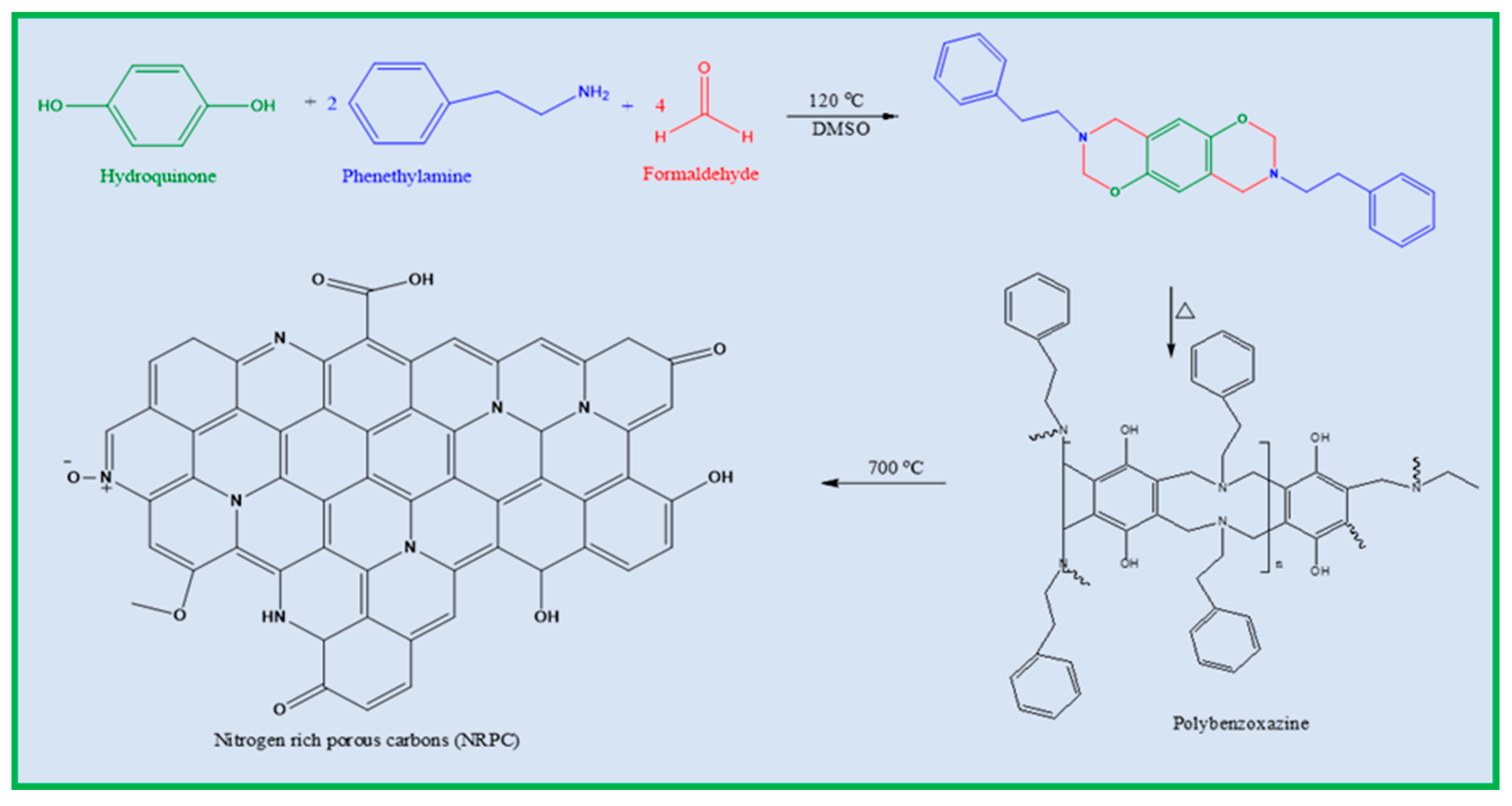
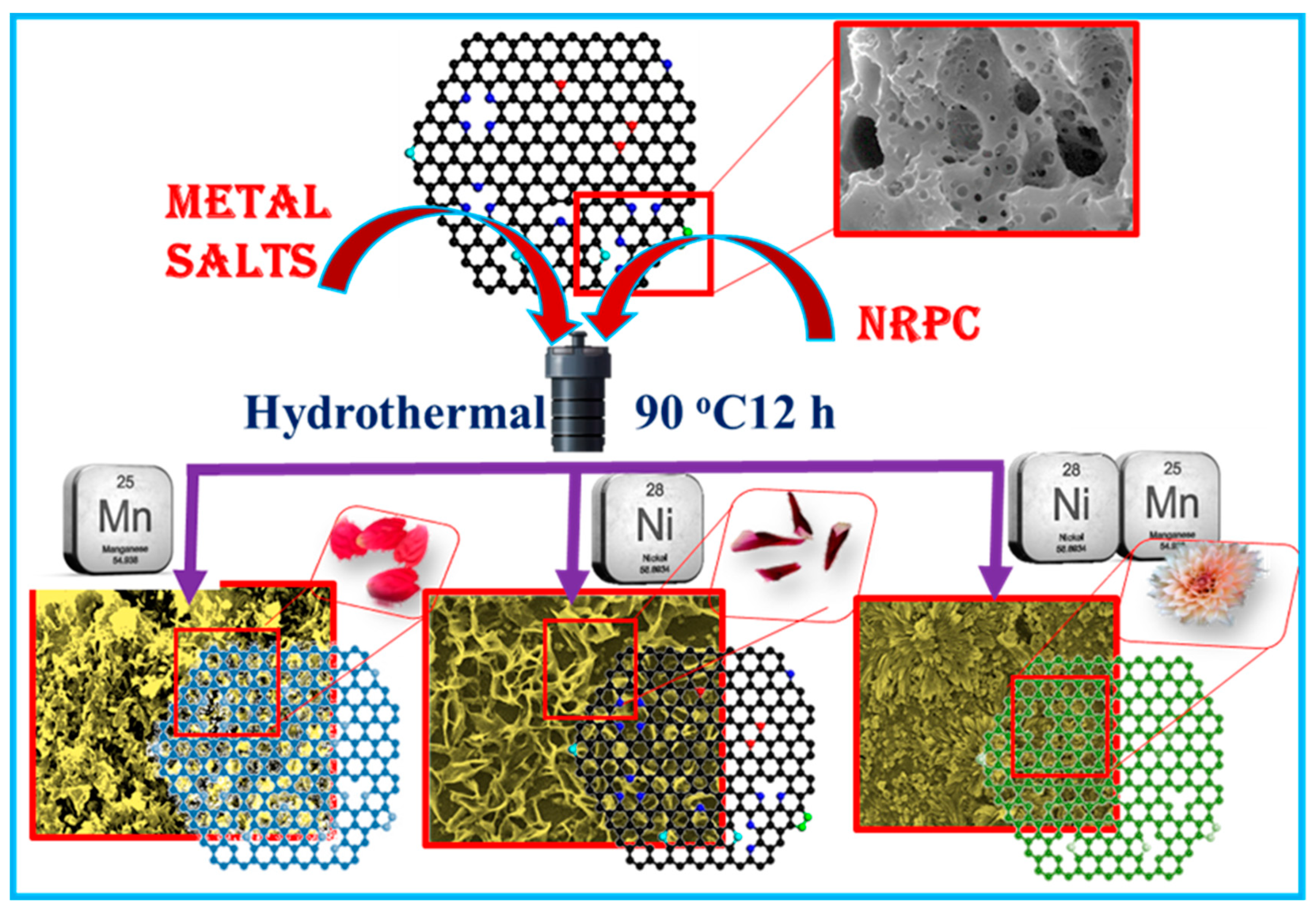
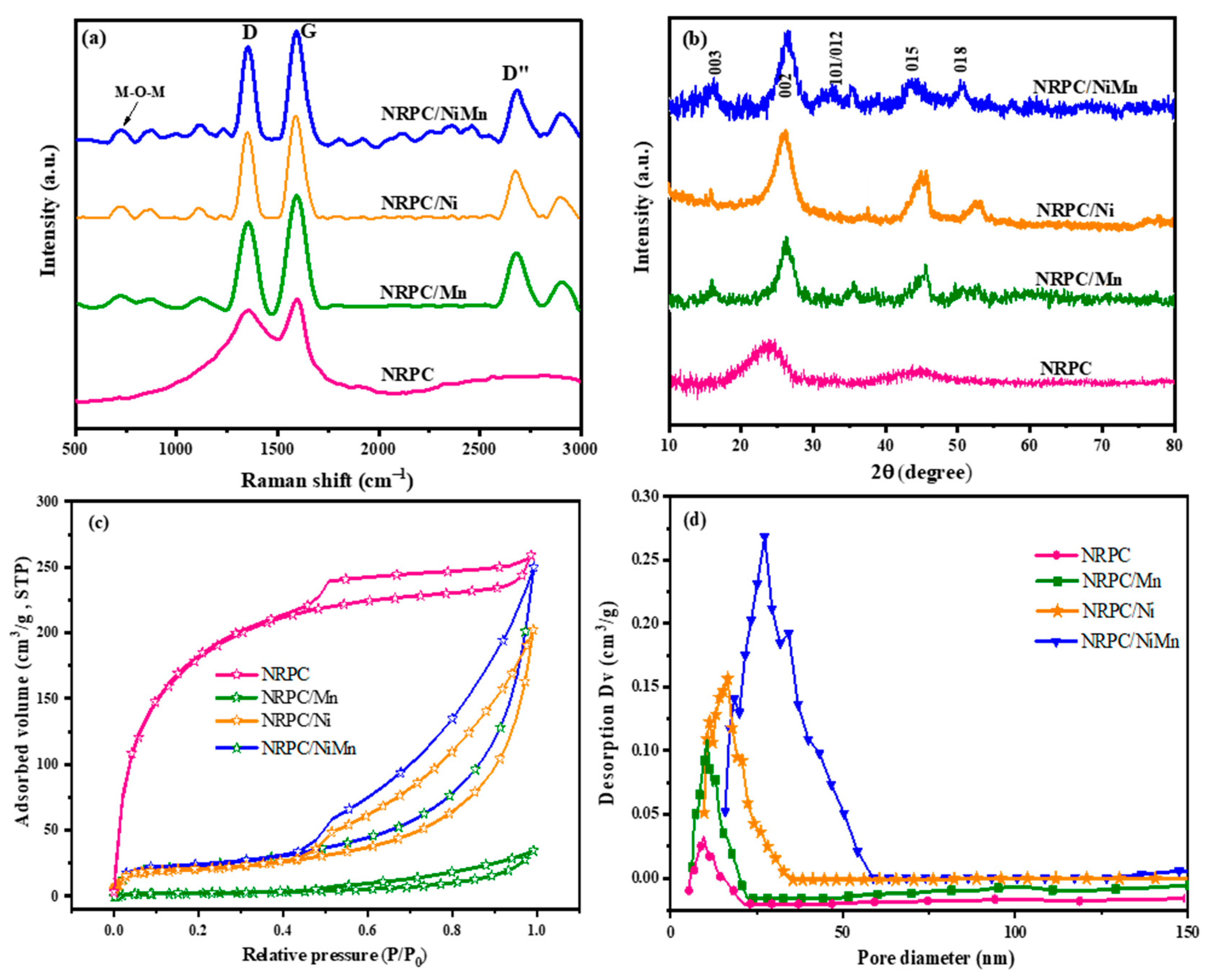
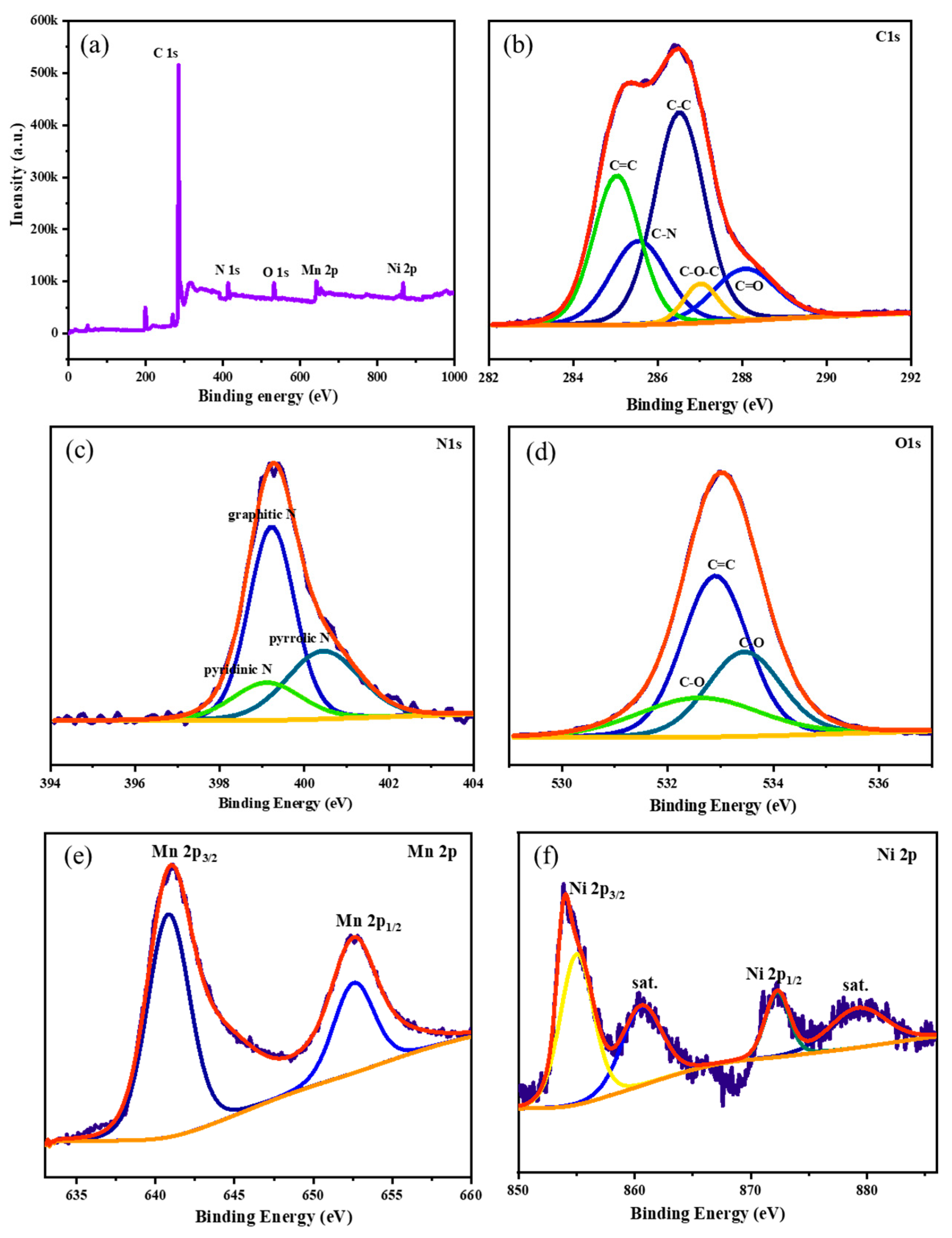

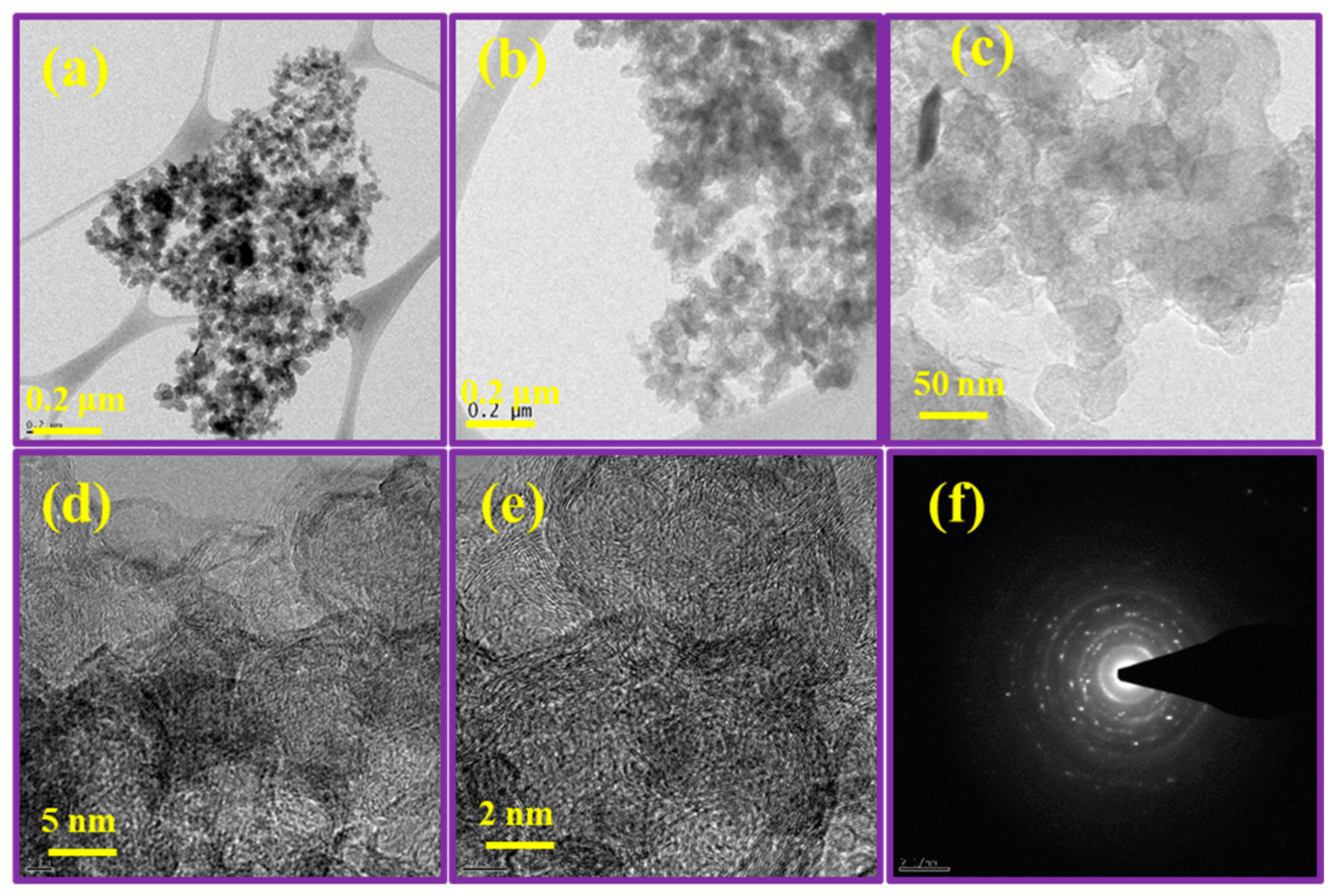
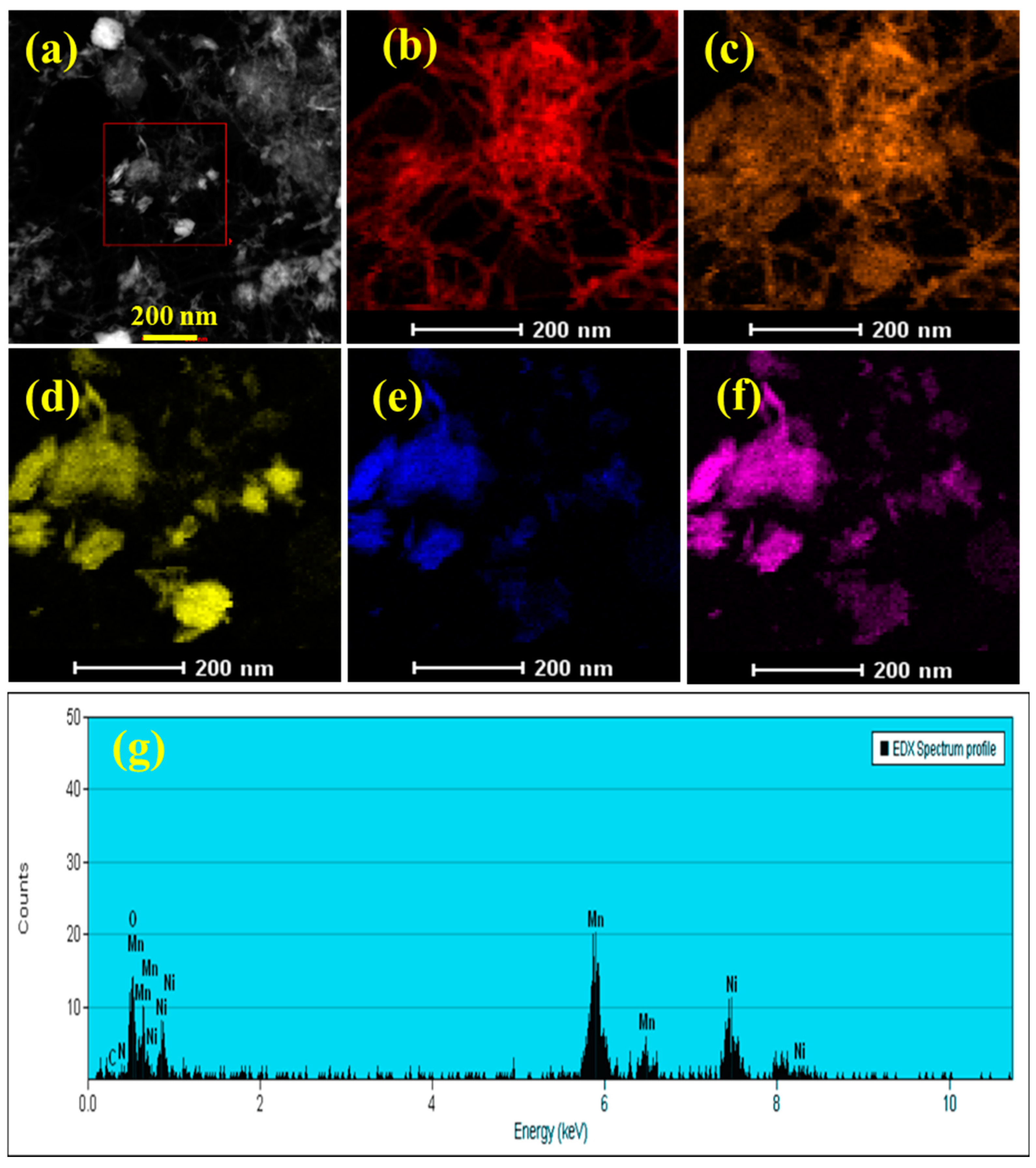
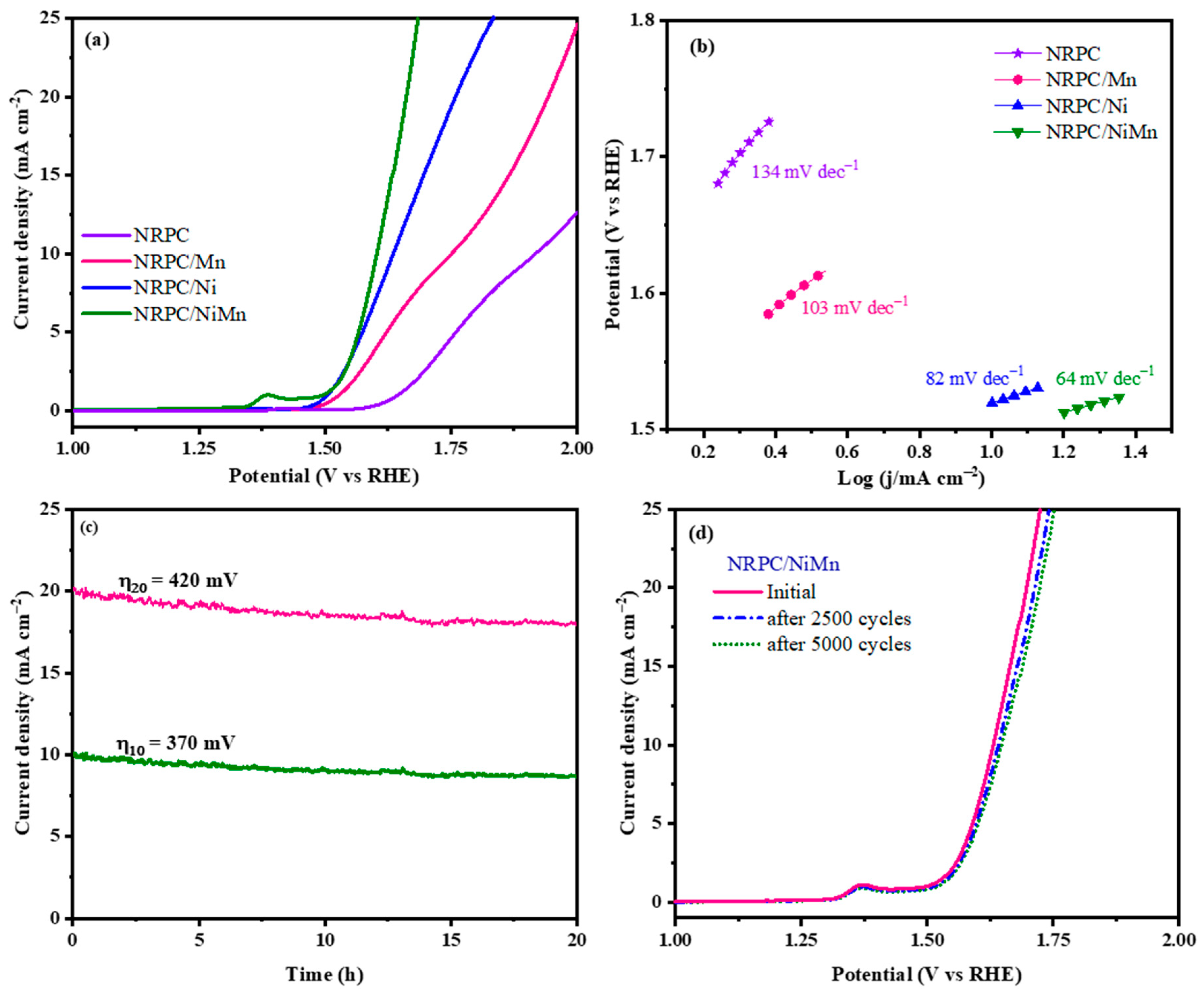

Disclaimer/Publisher’s Note: The statements, opinions and data contained in all publications are solely those of the individual author(s) and contributor(s) and not of MDPI and/or the editor(s). MDPI and/or the editor(s) disclaim responsibility for any injury to people or property resulting from any ideas, methods, instructions or products referred to in the content. |
© 2023 by the authors. Licensee MDPI, Basel, Switzerland. This article is an open access article distributed under the terms and conditions of the Creative Commons Attribution (CC BY) license (https://creativecommons.org/licenses/by/4.0/).
Share and Cite
Periyasamy, T.; Asrafali, S.P.; Kim, S.-C.; Lee, J. Facile Synthesis of Nitrogen-Rich Porous Carbon/NiMn Hybrids Using Efficient Water-Splitting Reaction. Polymers 2023, 15, 3116. https://doi.org/10.3390/polym15143116
Periyasamy T, Asrafali SP, Kim S-C, Lee J. Facile Synthesis of Nitrogen-Rich Porous Carbon/NiMn Hybrids Using Efficient Water-Splitting Reaction. Polymers. 2023; 15(14):3116. https://doi.org/10.3390/polym15143116
Chicago/Turabian StylePeriyasamy, Thirukumaran, Shakila Parveen Asrafali, Seong-Cheol Kim, and Jaewoong Lee. 2023. "Facile Synthesis of Nitrogen-Rich Porous Carbon/NiMn Hybrids Using Efficient Water-Splitting Reaction" Polymers 15, no. 14: 3116. https://doi.org/10.3390/polym15143116
APA StylePeriyasamy, T., Asrafali, S. P., Kim, S.-C., & Lee, J. (2023). Facile Synthesis of Nitrogen-Rich Porous Carbon/NiMn Hybrids Using Efficient Water-Splitting Reaction. Polymers, 15(14), 3116. https://doi.org/10.3390/polym15143116






